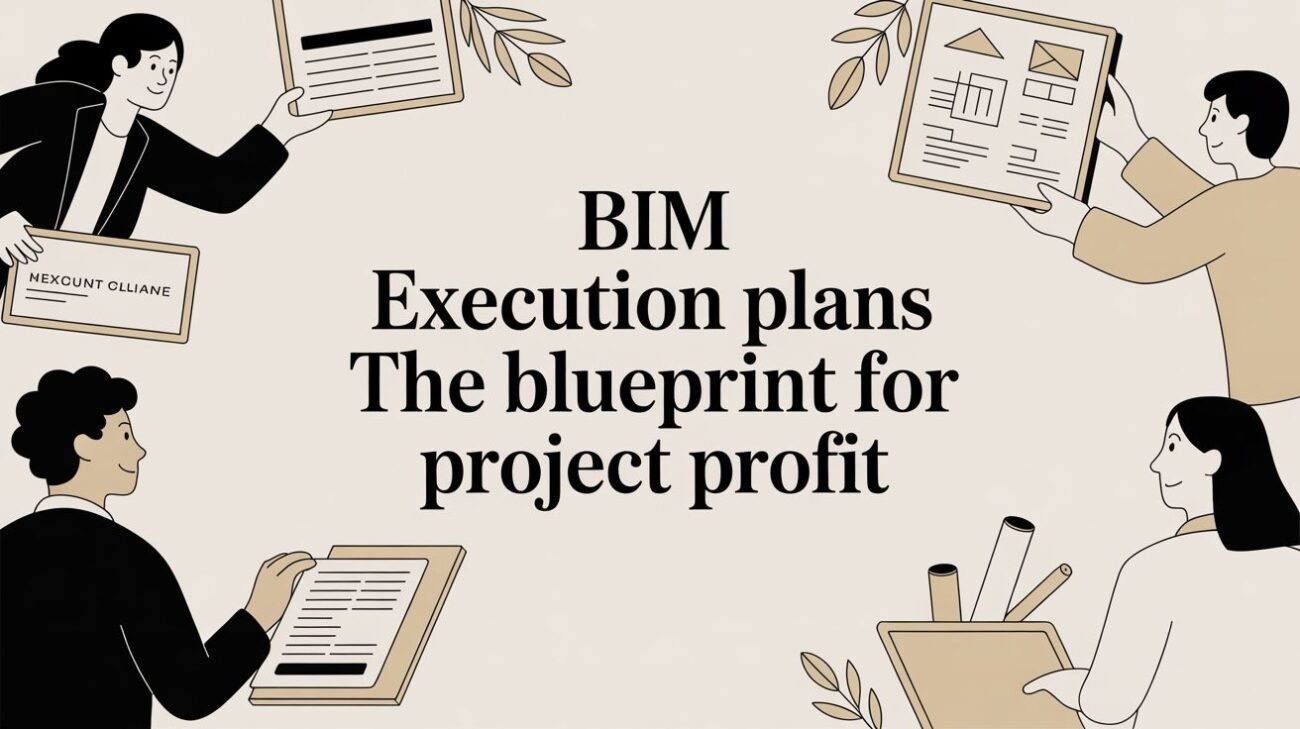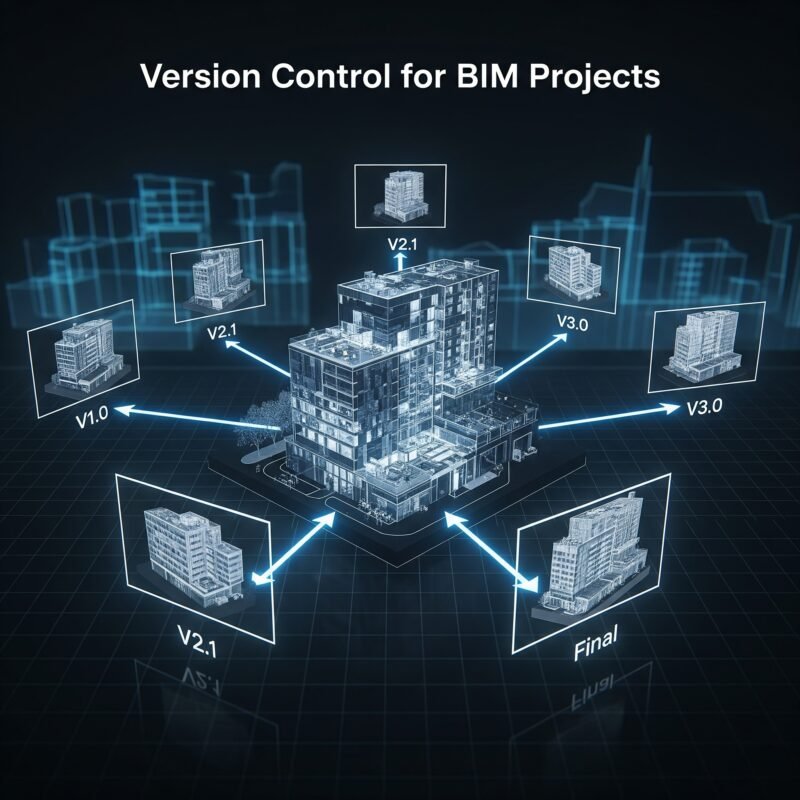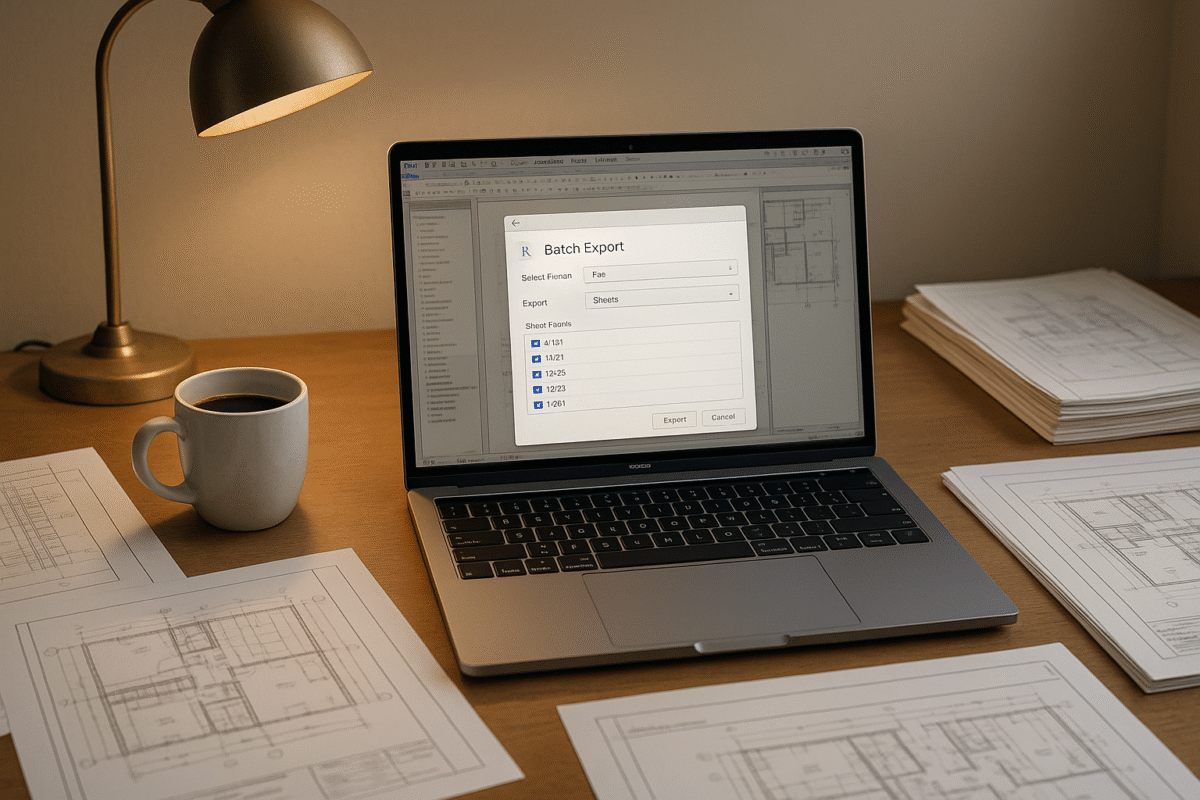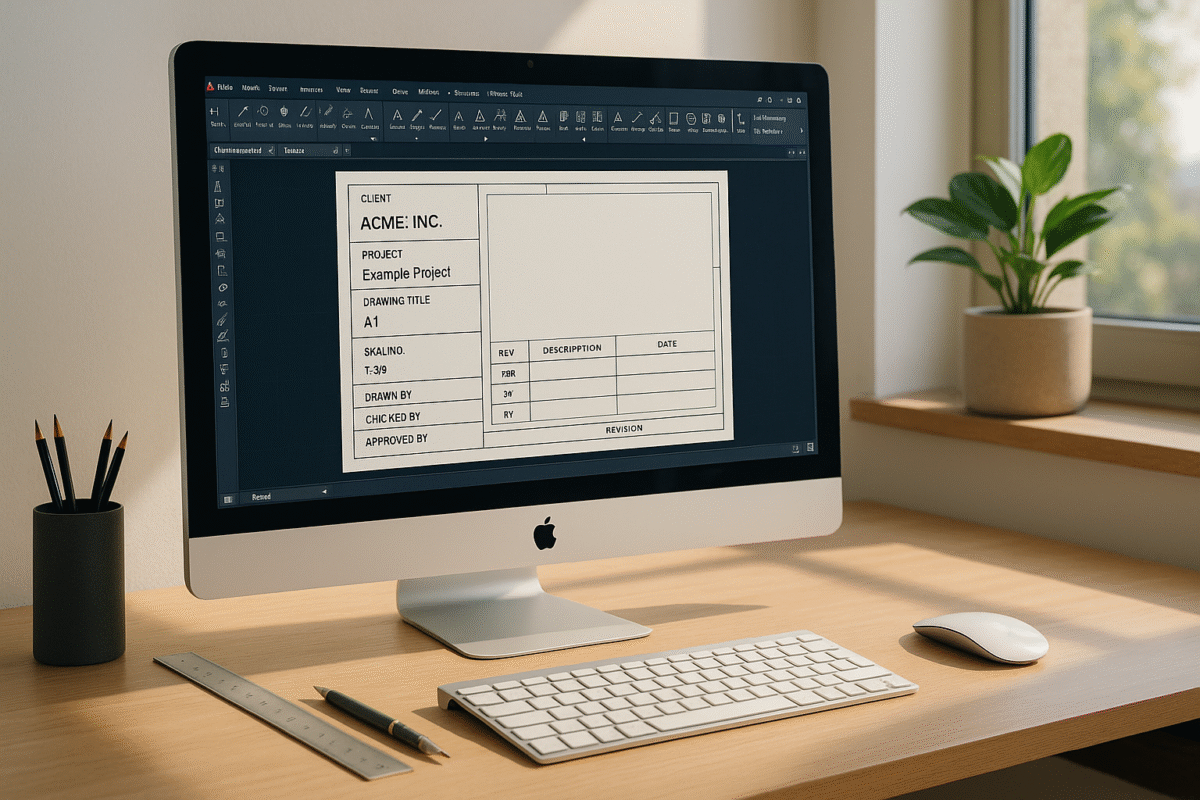How to Manage Multiple Projects Without Burning Out Your Team
Staring down a pipeline of conflicting deadlines is a familiar feeling in architecture and design. The constant context-switching, last-minute permit rushes, and sheer pressure on your design team aren't signs you need to work harder. They're signals your operational systems are maxed out. Learning how to manage multiple projects is less about juggling calendars and more about installing production discipline.
For small to mid-size architecture firms, builders, and design-build leaders, the daily reality is a chaotic shuffle between urgent tasks. You have markups scattered across platforms, designers jumping between deadlines, and that last-minute scramble for a permit set feels like just another Tuesday.
This isn't a personnel problem; it's a systems problem. The path to profitability and team sanity isn't found in individual heroics. It’s built on a predictable, repeatable production system that protects margins and guarantees quality. This means shifting your focus from just project management to production management—architecting a workflow that prevents fires in the first place.
From Juggling Deadlines to Systemizing Delivery
The chaos of managing multiple projects rarely starts in the production phase. It begins the moment a new opportunity walks in the door. When projects get green-lit based on gut feelings or fee potential alone, your entire production pipeline is immediately at risk. You can't achieve predictable multi-project BIM delivery if your intake process is a free-for-all.
Without a standardized intake, you’re flying blind. This is how firms end up with overlapping deadlines, mismatched resource needs, and a team stretched thin before a single line is drawn.

The Core of Production Maturity
To effectively deliver multiple BIM projects at once, there are a few non-negotiable principles. When firms don’t have these, they drown in rework, context-switching, and deadline collisions. A mature approach to AEC production planning always includes:
- Standardization: Aligned templates—from CAD layers to BIM view setups—eliminate guesswork and enforce operational consistency.
- Predictable Handoffs: Clear, documented protocols for when a project moves from one team or phase to the next. No ambiguity.
- Repeatable QA Cycles: Quality checks are scheduled and non-negotiable, catching errors before they become expensive problems or RFIs.
- Documented Decisions: A single source of truth for every choice made prevents endless debates and rework down the line.
This systems-first thinking is catching on. The global project management software market is expected to hit $7.24 billion by 2025, largely because firms need tools to coordinate complex workflows. It's a clear move toward systemization over brute-force effort.
We’ve seen teams deliver multiple active permit sets smoothly when the production system is standardized and decision checkpoints are non-negotiable. It’s about building a delivery engine, not just managing a to-do list.
This guide walks through the frameworks successful firms use to bring clarity and control to their project pipeline. By focusing on production maturity and solid BIM workflows, you create a calmer, more profitable environment. For a deeper dive into overarching strategies, explore how to manage multiple projects simultaneously. Our focus here, though, is on the AEC-specific systems that make scalable delivery possible, like those we cover in our overview of BIM and 3D modeling.
Create a Single Source of Truth for Your Project Pipeline
The first step toward operational control is building a standardized intake process. The fix is a simple but non-negotiable decision checkpoint at the front end of your workflow. It’s about shifting from a reactive "yes" to a proactive, data-informed decision that protects your team's focused time.
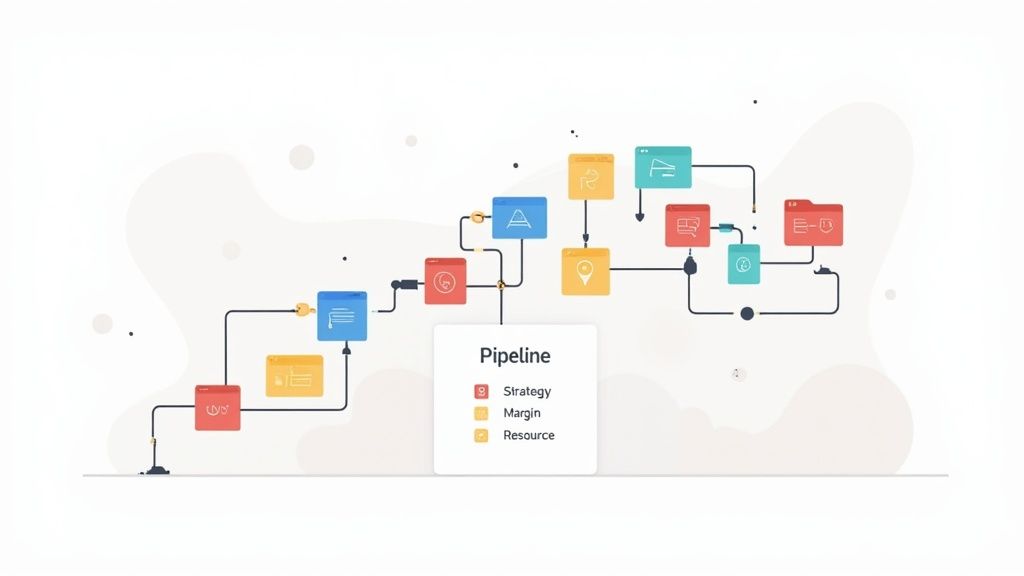
Build an Objective Project Priority Matrix
A project priority matrix is a straightforward framework for scoring new work against factors that truly matter to your firm's health. It moves the conversation away from emotion and into strategic alignment. This isn't bureaucracy; it's clarity.
Your matrix should reflect what you value. Key scoring criteria often include:
- Strategic Alignment: Does this project fit our long-term goals and build the portfolio we want?
- Margin Potential: Is the fee structure sound and does it protect our profitability?
- Resource Demand: Do we have the right team and capacity available without disrupting other commitments?
- Client Quality: Is this a collaborative partner or a client known for scope creep and late payments?
By assigning a weight to each category, you create a scoring system that quickly reveals a project’s true value. A high-fee project might score poorly if it requires a skillset you don't have or pulls your best team off two other profitable jobs.
This isn't just about filtering out bad projects. It’s a crucial checkpoint that forces an honest conversation about capacity and priorities. It's the first line of defense in protecting your team from overload.
Use this framework to objectively score incoming projects, ensuring you prioritize work that aligns with strategic goals and resource capacity.
Sample Project Intake Priority Matrix
| Scoring Criteria | Weight (1-5) | Project A Score (1-10) | Project B Score (1-10) | Weighted Score (Project A / Project B) |
|---|---|---|---|---|
| Strategic Alignment | 5 | 8 | 5 | 40 / 25 |
| Margin Potential | 4 | 6 | 9 | 24 / 36 |
| Resource Demand | 3 | 9 | 4 | 27 / 12 |
| Client Quality | 4 | 7 | 6 | 28 / 24 |
| Total Weighted Score | – | – | – | 119 / 97 |
This objective scoring makes it clear that while Project B might have a higher margin, Project A is a much better strategic fit and won't strain your team.
From Pipeline to Production Plan
Once a project is greenlit, it becomes part of a centralized pipeline—a single source of truth every leader can see. This master view is essential for effective AEC production planning. It shows not just what you're working on, but when those projects will demand key resources, allowing you to anticipate bottlenecks weeks in advance.
This level of clarity also reinforces discipline in how project information is handled. Establishing a logical file structure at kickoff prevents the digital mess that slows teams down. For firms serious about consistency, implementing clear best practices for version control in BIM projects becomes a natural next step, ensuring this single source of truth remains reliable.
Design Predictable Production Pods and Resource Plans
If your firm assigns people to projects based on who has a free moment, you're setting yourself up for missed deadlines and burnout. True multi-project management isn't about frantically shuffling individuals; it’s about building a scalable delivery engine through structured, predictable production teams.
The most effective model is creating production pods—small, dedicated teams that own a specific stage of the workflow. Instead of one person juggling schematic design for Project A and construction documents for Project B, you build focused units like a "Design Pod" or a "Permitting Prep Pod."
This model immediately attacks the biggest enemy of productivity and margin: context-switching. Production pods keep teams locked in, allowing them to build deep expertise and a consistent rhythm.
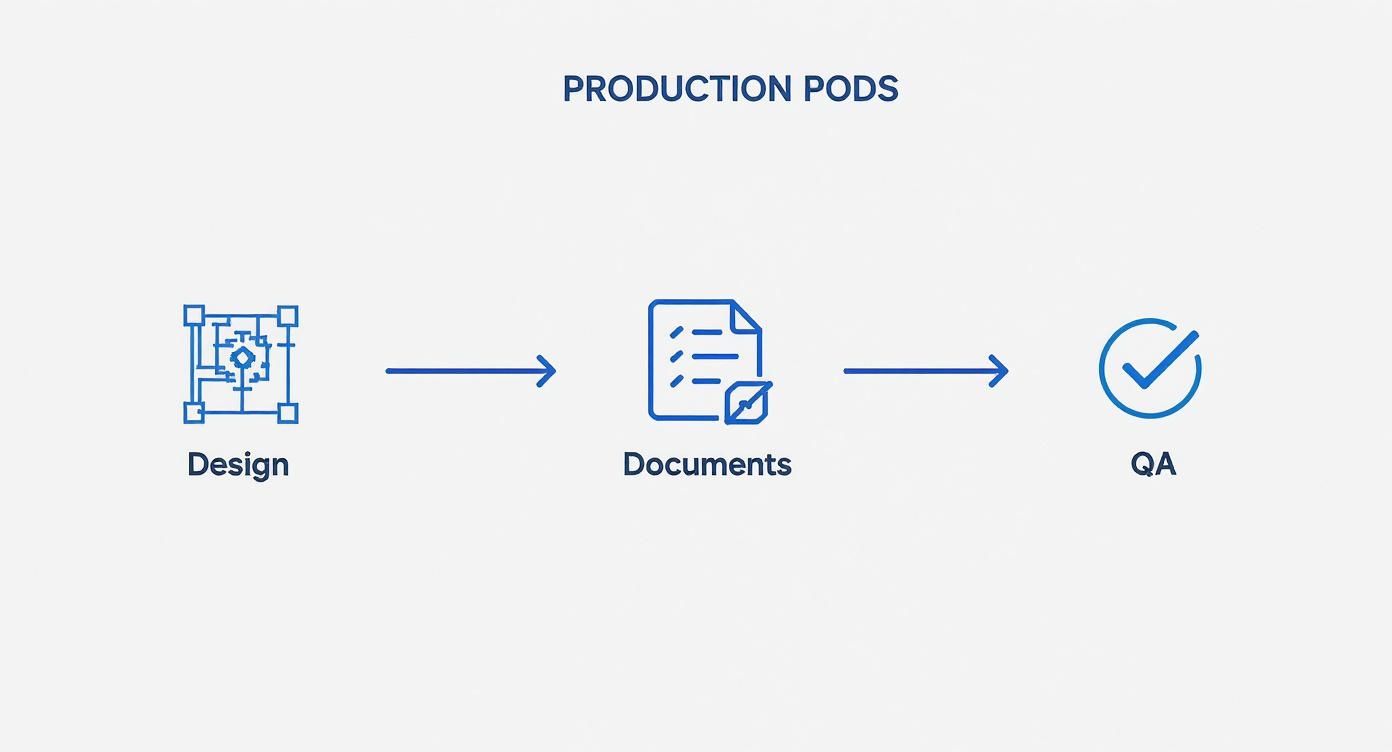
From Individual Assignments to Team-Based Pods
Shifting to a pod structure fundamentally changes your approach to AEC production planning. Your job becomes managing the flow of projects between these specialized teams. The handoff between pods becomes a critical, non-negotiable checkpoint where a rigorous QA checklist must be completed. This discipline forces quality at every step and kills the downstream issues that blossom into costly RFIs.
The benefits are immediate:
- Reduced Context-Switching: Teams stay focused, boosting speed and quality.
- Deep Expertise: Pod members become true experts in their phase, from navigating permitting quirks to mastering complex BIM workflows.
- Clear Ownership: It's always obvious which team is responsible for a project. No more finger-pointing.
- Simplified Onboarding: New hires can be dropped into a specific pod for targeted training.
When your resources are organized into pods, you suddenly see your firm’s true capacity. You know exactly how many projects your CD pod can handle, which lets you make smarter decisions during project intake.
Proactive Resource Planning and Bottleneck Prevention
With production pods, you can map out resource needs months in advance. This proactive planning is the secret to learning how to manage multiple projects without living in a constant state of emergency. You can look at your pipeline and see that in six weeks, three projects are set to hit the CD pod at the same time.
That's no longer a future crisis; it's a predictable bottleneck you can solve today. You can make a strategic decision with data, not react to a fire. This is a core idea detailed in The Architect's Comprehensive Guide to Project Management, which emphasizes building systems that anticipate needs. This operational rhythm is the foundation for scalable delivery.
Implement Standardized Workflows and Decision Checkpoints
Inconsistency is the silent killer of profitability. The constant hunt for the right CAD standard or the debate over which view template to use grinds production to a halt. When every project starts from a blank slate, you’re chipping away at your margins with every decision made twice.
Learning how to manage multiple projects effectively means establishing a common operational language. This isn't about stifling creativity; it's about creating a predictable foundation so your team can focus on design, not reinventing basic processes.
The Power of Aligned Templates and Processes
Standardization is the bedrock of scalable project delivery. When your team has a shared set of tools and rules, a designer can jump from Project A to Project B without missing a beat. This operational consistency is your firm’s best defense against rework and last-minute rushes.
Key areas for immediate standardization:
- CAD and BIM Templates: Enforce a single set of view templates, sheet layouts, and component families for a consistent look and feel.
- File Naming and Folder Structures: Create a logical, non-negotiable system for where project files live.
- QA/QC Checklists: Develop standardized checklists for each major project phase to guide internal reviews.
Non-Negotiable Decision Checkpoints
Along with standardization, you need firm decision checkpoints. These are scheduled, mandatory gates a project must pass before it can advance. They are quality control filters that catch problems early and prevent scope creep.
These checkpoints force deliberate pauses for coordination and sign-off, preventing the "runaway train" effect that dooms so many projects.
We’ve seen teams deliver multiple active permit sets smoothly when the production system is standardized and decision checkpoints are non-negotiable. They are your best defense against endless RFIs.
These checkpoints should be built directly into your architect project management workflows. Examples include a mandatory internal design review before a client presentation or a final QA check before issuing for permit. For these to be effective, they must be tied to a clear set of standards, which is where a guide on creating BIM Execution Plans can provide the necessary structure.
Technology plays a huge role here. Project management software saves employees an average of 498 hours per year. Yet, only 23% of organizations use dedicated PM software. Among high-performing projects, however, a staggering 77% rely on it, proving its value.
By marrying firm-wide standards with enforced checkpoints, you create a production system that is resilient and repeatable. This is how you achieve operational consistency and protect your margins.
Establish a Communication Rhythm and Documented Decisions
When your team is spread across a half-dozen projects, you can't leave communication to chance. Ad-hoc email chains spiral, hallway conversations are never written down, and markups get scattered across platforms. This isn't just messy; it's a direct path to costly rework. Solid multi-project BIM delivery depends on making information flow predictable, accessible, and documented.
Move from Ad-Hoc Updates to Scheduled Check-ins
Establish a predictable rhythm for communication. This doesn't mean more meetings. It means better meetings with a clear purpose.
- Weekly Project Syncs: Hold a brief, standing 20-minute meeting for each active project. The agenda: What did we accomplish last week? What are the priorities for this week? Any roadblocks?
- Centralized Discussion Platform: Move project-specific conversations out of email and into a dedicated channel in Slack or Microsoft Teams. This creates a searchable record.
- Clear Escalation Paths: Define who on the team owns what and establish a clear protocol for when an issue needs to be escalated.
This rhythm turns communication from a distraction into a reliable part of your architect project management workflows, protecting your team's focus.
When you don't have a system, the person who yells the loudest gets the attention. A structured communication rhythm ensures project priorities are driven by strategy, not panic.
The Power of a Simple Decision Log
One of the most powerful tools you can implement is a Decision Log. This shared document—a simple spreadsheet—becomes the single source of truth for every key choice made. Memories fade, but a documented decision is permanent.
| Column | Description |
|---|---|
| Date | When the decision was made. |
| Decision | A clear, concise statement of the choice. |
| Rationale | The "why" behind the decision. |
| Made By | Who had the final say (e.g., Project Architect, Client). |
| Next Steps | Any immediate actions required. |
This log is your ultimate defense against the "I thought we decided to…" conversation. It prevents rework and clarifies accountability. As noted in a guide on how to map out debates in the scholarly literature, documenting positions is critical for creating clarity—a principle that applies directly to project management. By creating a disciplined communication rhythm and a formal process for documenting decisions, you replace chaos with clarity.
Your Path to Predictable and Scalable Delivery
Successfully juggling multiple projects isn't about hustle. It’s about building a mature production system that brings clarity, consistency, and control to your firm. It’s how you create operational leverage, letting your firm grow without the pain of constant rework, missed deadlines, and a burned-out team.
From Individual Effort to Systemized Execution
This guide has laid out the core pillars of that system: a disciplined intake process, structured resource pods, standardized workflows, and non-negotiable decision checkpoints. These are the elements that protect your margins, make delivery dates predictable, and allow your firm to scale without adding chaos.
The path to smoother project delivery isn't paved with more effort—it's built on a foundation of operational discipline. You don't just deliver projects; you have a system for reliable delivery.
This operational maturity is the key to creating consistency in your multi-project BIM delivery. It shifts your focus from managing calendars to managing a production engine. To dig even deeper into these strategies, check out this comprehensive guide on mastering multi-project management.
By embracing these frameworks, you stop being a firm that just juggles projects and become one with a reliable, repeatable system for delivering excellence. To help you systemize your own pipeline, we've created a Project Pipeline Priority Matrix template. It’s a straightforward tool to help you start making strategic intake decisions that protect your team and your bottom line.
Got Questions? We’ve Got Answers.
Shifting from a reactive hustle to a systems-driven approach always brings up questions. Let's tackle the most common ones.
How Can We Implement These Systems Without Disrupting Current Projects?
The secret is to go for small wins first. Don't overhaul everything at once. Pick one new standard and pilot it on a single, upcoming project.
Low-disruption ideas that work:
- Standardize your project file structure: On the next project kickoff, apply a new, logical folder system.
- Introduce a single QA checklist: Create a simple quality assurance checklist for one critical handoff, like moving from schematic to design development.
- Trial a decision log: Use a shared spreadsheet on one project to track key decisions. When it prevents rework, its value becomes undeniable.
This approach lets you fine-tune the process and gives your team a tangible win, which is the best way to build momentum. Think evolution, not revolution.
What Is the Biggest Mistake Firms Make When Trying to Manage Multiple Projects?
The most common trap is thinking it's a resource problem ("we just need more people") when it's really a systems problem. Adding staff to a chaotic production process just creates more chaos and jacks up your overhead. You’re not fixing the root cause; you're just throwing money at the symptoms.
The most successful firms we've worked with focus on stabilizing their production engine first. They standardize templates, clarify handoffs, and create non-negotiable checkpoints.
Only after the system is predictable do they add more fuel by taking on more work or hiring new team members. Fix the engine before you try to go faster.
How Does This Approach Apply to a Very Small Firm?
These principles are actually more critical for small firms. With a lean team, everyone wears multiple hats, and the cost of context-switching is a massive productivity killer. A standardized workflow allows a small team to punch way above its weight.
Simple checklists, a clear file structure, and a project priority system are your best defense against burnout. This discipline empowers a small firm to handle a larger volume of work with far less stress and fewer mistakes—a direct win for your profit margins and your team's sanity.
At BIM Heroes, we’ve seen firsthand that scaling your firm’s capacity isn't about working harder—it’s about putting smart, robust systems in place. If you're ready to trade project chaos for predictable production, we can help you build the engine.


